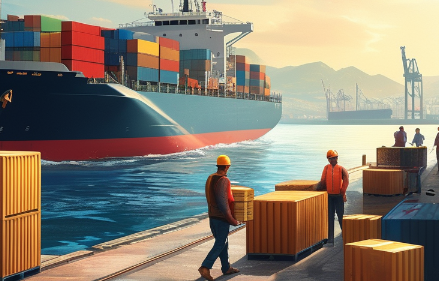- By TOP CHINA FREIGHT
- August 5, 2025
- Shipping
Shanghai Port City stands as China’s premier maritime hub and the world’s busiest container port, serving as the beating heart of international shipping for over a decade. Anchored by deep-water terminals like Yangshan and Luojing, it’s a testament to urban-logistical synergy and strategic infrastructure planning.

1.Overview of Shanghai Port City
The Port of Shanghai, situated along the Yangtze River Delta, spans both deep-sea and river ports, making it one of the most versatile shipping hubs in the world. It has held the title of the world’s busiest container port since 2010, handling over 47 million TEUs (Twenty-Foot Equivalent Units) in recent years.
Operated primarily by the Shanghai International Port Group (SIPG), this mega port combines cutting-edge automation, vast logistics capacity, and seamless intermodal connections that link sea, rail, air, and road freight.
Key Facts:
- Location: Yangtze River Delta, East China
- Throughput (2024): 47.3 million TEUs
- Main Terminals: Yangshan Deep Water Port, Waigaoqiao, Wusongkou
- Operator: Shanghai International Port Group (SIPG)
2.Strategic Importance of Shanghai Port City
Shanghai port city is a gateway for over 200 countries and regions. Its infrastructure is designed to handle both import and export cargo efficiently, connecting manufacturers in inland provinces to international buyers.
Global Connectivity
Thanks to its location near major international sea lanes and the mouth of the Yangtze River, the port city facilitates:
- Container transport to North America, Europe, and Southeast Asia
- Bulk cargo handling for coal, oil, and agricultural goods
- Ro-Ro shipping for vehicles and machinery
- Cruise and passenger traffic
3.Major Terminals and Facilities
Yangshan Deep Water Port
Located on the islands of Greater and Lesser Yangshan, this terminal is connected to mainland Shanghai by the Donghai Bridge, one of the longest sea bridges in the world. It features:
- Fully automated cranes
- Intelligent tracking systems
- Capacity to handle ultra-large container vessels (ULCVs)
Waigaoqiao Terminal
This terminal cluster is closer to the urban area of Shanghai and handles a mix of container and general cargo. It’s a key area for LCL (Less than Container Load) cargo and bonded warehousing.
Wusongkou Terminal
Although smaller, Wusongkou serves as a river port and cruise terminal, supporting Shanghai’s domestic logistics network and tourism.
4.Intermodal Transportation Infrastructure
To keep the cargo moving, Shanghai port city is supported by a robust multi-modal network:
- Rail freight: Direct trains connect the port with major cities in China and across Eurasia via the China-Europe Railway Express.
- Road freight: Advanced highway systems link the port to inland provinces.
- Air cargo: Proximity to Shanghai Pudong International Airport ensures rapid transport of high-value goods.
5.Environmental Innovations
As global shipping faces growing environmental scrutiny, Shanghai port city is leading in green transformation:
- LNG-powered tugboats
- Shore power for berthed ships
- Smart port systems to reduce idle time and emissions
6.Role in the Belt and Road Initiative
Shanghai port city plays a strategic role in China’s Belt and Road Initiative (BRI), acting as a maritime hub for the 21st Century Maritime Silk Road. Its connections to Europe, Africa, and Southeast Asia make it a focal point for global logistics planning and investment.
7.Why Shanghai Port City Matters to Global Trade
From automotive parts to fashion goods, electronics to industrial machinery—Shanghai port city is where East meets West in trade. Businesses around the world rely on its efficiency, reliability, and scale to keep supply chains flowing.
Whether you’re a multinational importer or a small exporter, understanding the significance and capabilities of Shanghai port city is essential for modern logistics strategy.
Conclusion
Shanghai port city stands as a global benchmark in maritime logistics and supply chain efficiency. Its world-class terminals, integrated transport systems, and advanced technology make it a preferred gateway for international trade. Whether you’re shipping full container loads, bulk cargo, or time-sensitive goods, leveraging the capabilities of Shanghai port city can give your business a strategic edge.
As global trade continues to evolve, Shanghai remains at the heart of Asia’s logistics revolution—connecting manufacturers, traders, and consumers across continents.
Ask for a quote
Looking to ship goods through Shanghai port city?
TJ China Shipping Forwarder offers tailored solutions to help businesses of all sizes ship more reliably from China.
FAQs
Q1: Is Shanghai the busiest port in the world?
Yes, the Port of Shanghai has been the world’s busiest container port since 2010.
Q2: What types of cargo are handled in Shanghai?
Shanghai handles containers, bulk cargo, vehicles (Ro-Ro), chemicals, oil, and more.
Q3: How is Shanghai port city connected to the rest of China?
Via a network of expressways, freight railways, and airports, offering seamless multi-modal shipping solutions.
Q4: What are bonded zones, and why are they important?
Bonded zones allow cargo to be stored and processed without immediate customs clearance, speeding up trade processes.
Q5:Are there environmental or sustainability initiatives at the port?
Yes. Shanghai port is investing in green port technologies, including shore power systems, LNG-powered vessels, low-emission equipment, and digital traffic management to reduce carbon emissions.
